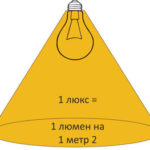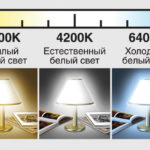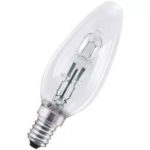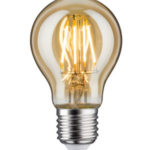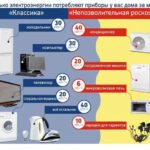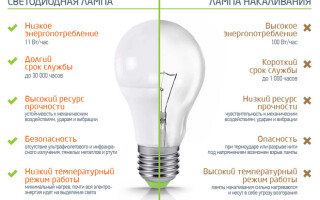With the development of technology and the advent of energy-saving lamps on sale, more and more people are thinking about whether it is worth overpaying for an energy-saving lamp and how much better it is than a conventional incandescent bulb. To answer this question, it is necessary to understand what characteristics are important for light sources and how they differ for different types of lamps.
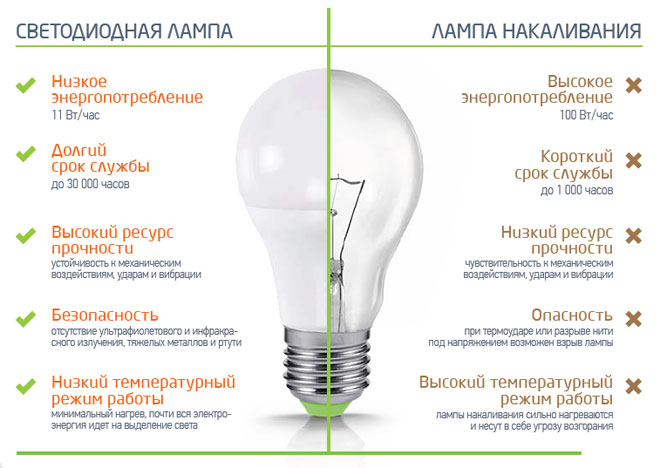
Content
Differences in design and principle of operation
For the first time, a patent was obtained for a light source with a tungsten filament by the Russian scientist A.N. Lodygin in the 90s of the XIX century. Such lighting lamps work on the principle of incandescent filament of a special tungsten alloy to very high temperatures, which inevitably leads to a glow. Structurally, such a device consists of a glass flask with a chemically inert gas inside (for example, mixtures of nitrogen and argon), tungsten spiral (filament), molybdenum filament holders with other elements to hold the filament and electrical conductors with a base at the bottom of the lamp.
Such lamps are widely used in all spheres of human activity, but they are gradually being replaced by modern and efficient LED lighting devices.
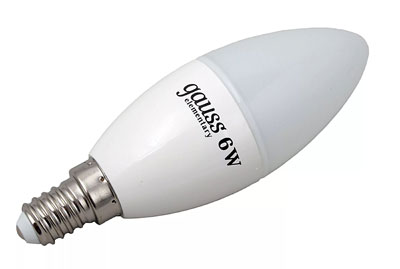
LED lamps were discovered at the beginning of the 20th century, but for the first time they received practical application only in 1962, when Nick Holonyak, an American scientist from the University of Illinois, received crystals with a red glow. The principle of the glow of the LED is in the electro-hole transition, characteristic of semiconductor elements. When an electric current passes in the forward direction through the LED, photons are emitted and a glow appears.
With the development and improvement of technological processes, the production of LEDs has ceased to be expensive and LED lamps have become widespread, rapidly displacing incandescent lamps from the market. All this happens because such devices have a high efficiency and, at low power, have a large luminous flux.
To understand what power, light output, efficiency are and how it all relates to the choice and popularity of LED lamps, we will analyze each property in more detail.
Power and light output
One of the important parameters of lighting devices is their light output. It is from this characteristic that one can understand how efficient the lighting device is and how much energy it consumes. Light output directly depends on two quantities: the luminous flux and the power of the device.
What is luminous flux?
Light flow - this is a value that shows the amount of generated light energy per unit of time. It is measured in lumens (denoted lm or lm). Appliance power - this is the amount of electrical energy that the device consumes and converts.
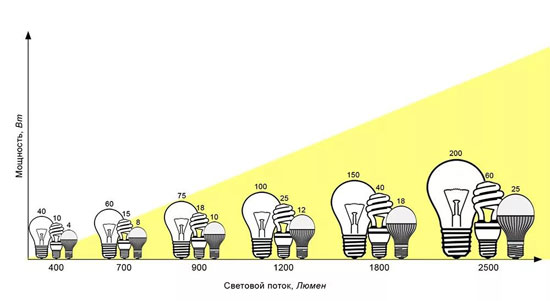
The luminous efficiency of lighting fixtures shows the ratio of luminous flux to lamp power. Incandescent lamps are outsiders in this characteristic and have a very low light output (this is due to the fact that power is spent not only on light radiation, but also on thermal radiation, and this, of course, reduces the efficiency of the device). Perfect and high-quality LED products have a large luminous flux, at low power, which increases the light output many times over.
Table 1. Luminous flux ratio comparison table (lumen) to the lamp power consumption (Tue) for LED lamps and incandescent lamps
| Power, W | Luminous flux, lm | |
|---|---|---|
| incandescent | LED | |
| 25 | 3 | 255 |
| 40 | 5 | 430 |
| 60 | 9 | 720 |
| 75 | 11 | 955 |
| 100 | 14 | 1350 |
| 150 | 19 | 1850 |
| 200 | 27 | 2650 |
Heat dissipation
Heat dissipation of the lighting device - This is a negative and harmful characteristic for lighting lamps. The higher the temperature of the device during its operation, the more energy it wastes on unnecessary heating. Moreover, excessive lamp temperature may cause burns (by accidental contact with the lamp) or to fire and damage to finishing materials (for example, a plastic or stretch ceiling may melt). According to this parameter, incandescent lamps are noticeably inferior to LED ones, they heat up very much and spend a large amount of energy on heating. This, of course, is connected with the principle of operation of this lighting device.
Of course, it cannot be said that LED lamps do not heat up. But in comparison with classic incandescent lamps, they have low heat transfer and high efficiency. They can be used in paper and plastic lamps without fear that they will catch fire.
Life time
Everyone is familiar with the situation when the incandescent lamp "burned out". Any power surge while the device is running or a sharp switch on when the tungsten filament is worn out leads to damage to the incandescent lamp. It is because of the high sensitivity of the filament that ordinary lamps have a short service life, and low-quality incandescent lamps last only a few days.
Energy-saving LED lamps have a fundamentally different design and predictable service life. Such devices last ten times longer than incandescent lamps and can last up to 50,000 hours (for comparison, the average life of incandescent lamps does not exceed 1000 hours).
lamp efficiency
Efficiency (efficiency) are closely related to all previous parameters of lighting lamps. Each device has a "useful action" - this is the work for which, in fact, the device was created. In lamps, the main beneficial effect is the emission of light. Everything else is superfluous and unnecessary work and reduces efficiency. Incandescent lamps have a very low efficiency, because the main part of its work is associated not with a useful action, but with a side effect - heat radiation. This value (efficiency) for such lamps barely reaches 5%. This means that only 5% of the electrical energy consumed is spent on light emission. And this is a very low figure. He talks about the inefficiency and inefficiency of the device.

LED lamps have a high efficiency, which is about 90%. That is, LED devices do not waste energy on useless work and save electrical energy, and, therefore, save the user's budget.
Environmental friendliness
Unfortunately, only in the 21st century people began to consciously think about the conservation of nature and the environmental friendliness of the devices they use. A key role in the conservation of nature in the future is the reasonable consumption and saving of energy now. Modern methods of obtaining electrical energy cause great harm to the natural resources of our planet.
Gradually polluted water resources, atmosphere and soil when using non-renewable energy sources. This leads to global warming and rising ocean levels, and, consequently, to an environmental disaster. Energy conservation is one of the ways to reduce the negative impact of mankind on the environment. Not just like that, in the world, the action "Earth Hour" has become popular, when for one hour all people who are not indifferent to nature turn off all electrical appliances in their homes.
In this sense, energy-saving LED lamps and the transition to them around the world have taken a big step towards reducing electrical energy consumption. After all, LED lamps are low-power, but effective devices. LED lamps allow you to spend electrical energy reasonably.
Based on the above, there is no reason not to use LED lamps. Of course, they are somewhat more expensive than incandescent lamps, but in all respects they are ahead of them.The use of modern LED lighting sources helps to save the budget and the environment in the world and, of course, pays off in long-term use both for a particular person and for all of humanity as a whole.
Similar articles:
